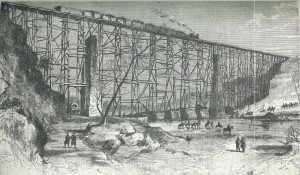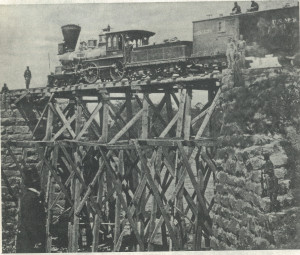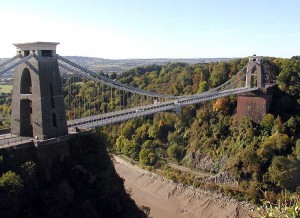The rule of the thumb
Though Rail Engineering is a world full of old timers, there are few remaining who still remember the halcyon days when long experience in practical construction was what defined the master bridge builder. The trade could be learnt when young from an older master and the rules of thumb learned were good to ensure the design was sound. After building about 5 trestle bridges such a competent bridge designer could strike out independently, perhaps later on in their career setting aside time to train up the next generation.
The following excerpt from that world is quoted from Mark Aldrich’s excellent book “Death Rode the Rails” (Ch 5):
 Typical American “Beanpole” bridge in mid 1800s
Typical American “Beanpole” bridge in mid 1800s
“Sometime after 8:oo p.m. on December 29, 1876, the Lake Shore & Michigan Southern Pacific Express, traveling west out of Erie, Pennsylvania, approached the Ashtabula, Ohio, bridge, just east of the station. The train consisted of three express and one baggage cars, three passenger coaches, and three sleepers hauled by two locomotives – the Columbia and the Socrates. The weather was foul, with snow and sleet driving off of Lake Erie, and the Socrates’s engineman Daniel McGuire slowed his train and cautiously approached the bridge. When he was nearly across, it gave way, dropping all of the train save his own engine about 65 feet into the chasm, where car stoves ensured that the wreckage immediately caught fire. The death toll was eighty-nine, including two officers of the company. It was the worst railroad disaster of the century.
“Ashtabula was what civil engineers called a “square fall”- that is, the bridge failed for lack of strength. Immediately after the event the Ohio legislature commissioned an investigation by a panel of engineers. The bridge was an iron Howe truss that Amasa Stone had designed for the Cleveland & Erie railroad after he had become its president. Stone was an old-time bridge builder who had worked with Howe and patented modifications of the original Howe truss, but who lacked scientific training. The engineers’ report, which the Engineering News termed “full and satisfactory,” concluded that Stone’s bridge was in sound condition but suffered from numerous design errors. Among the many such flaws was that the top chord had a factor of safety of only 1.6 when sound engineering practice at that time employed a factor of at least 5. Moreover, the chord consisted of five unconnected beams, which implied that it had little lateral strength. Reviewing this evidence, the eminent bridge engineer Theodore Cooper concluded, “its failure has taught us nothing that we did not know before.”
“Cooper was a member of an emerging fraternity of professional bridge engineers. Educated at Rensselaer Polytechnic Institute, Cooper worked as a railroad engineer and instructor of engineering at the U.S. Naval Academy and then for several bridge companies before launching his long distinguished career as a consulting bridge engineer. For such men, Ashtabula symbolized the problem of bridge failures as they saw it. The old rules of thumb that had dominated American practice since the beginning led to unscientific designs that resulted in square falls. Thus the central problem of bridge safety, in this view, was the need for scientifically informed bridge designers.”
This was just at the time when Engineering Schools were starting to turn out the first generation of Professional Engineers who were young and full of new fangled theory. These were men who relied on Engineering Tables and calculation to make their work safe. Aldrich again:
“With the publication of works by Squire Whipple and Herman Haupt, competent engineers computed strain diagrams that calculated the load on each member, whether in tension or compression, from the dead load of the bridge and some assumed live (train) load. Experiments by William Fairbairn for the English Iron Commission published in 1850 and by the German engineer August Wohler established the ultimate strength of wrought iron at around 50,000 psi and its elastic limit at about half that level, although both might vary substantially with the quality of the iron. Similar calculations were done for cast iron and wood. Thus, by the Civil War, a skilled engineer armed with such information could proportion all bridge members to be able to withstand the assumed stress with a safety factor of 4 or 5 (relative to the breaking strength) to allow for the uncertainties in the process.”
Typical American trestle bridge being acceptance tested
“But not all bridge builders pursued the path of science. Thomas Appleton told the Boston Society of Civil Engineers that “in view of the prevailing lack of system, or ‘rule of thumb,”‘ he was surprised how few Howe trusses had collapsed. He had once computed the stress on some Howe truss bridges and found that the iron needed to be much stronger.
“He showed his calculations to one of the pioneer builders, who dismissed them with the comment “we never use such heavy iron as that.” Another writer told the British Institution of Civil Engineers of early American timber bridges in which the iron tension rods carried a stress of 46,000 psi when accepted procedures limited stresses to 10,000 psi. As late as 1893 the superintendent of bridges and buildings on the Big Four Railroad sent the Railway Review photographs of two trestles that he termed “death traps” because they lacked either lateral or diagonal bracing.
“The results of such practices were nicely illustrated in 1850 on the Erie when one of Rider’s Patent Iron Bridges gave way, moving the railroad to abandon iron altogether for a time. Although Rider’s bridge had been praised by the American Railroad Journal and won an award from a committee that included the distinguished engineers Horatio Allen and John B. Jervis, it was fatally flawed.”
It is hard to be nostalgic for those particular “good old days”.
But even back then there were places where the theoretical and calculation skills of the young Professional Engineer could be held in high regard. Brunel’s first attempt at bridge design, for instance, is still standing.
Clifton Bridge in Bristol. Picture taken by Adrian Pingstone in October 2003 and placed in the public domain
Stories of his Professional Assessors seen departing Bristol Town Hall muttering:
“I had him pegged for a tunnel engineer more than a bridge designer; and even then I would have liked to see him design a couple more tunnels before I’d regard him as truly competent …”
are almost certainly apocryphal.
- Categories
- Engineer technical
admin



